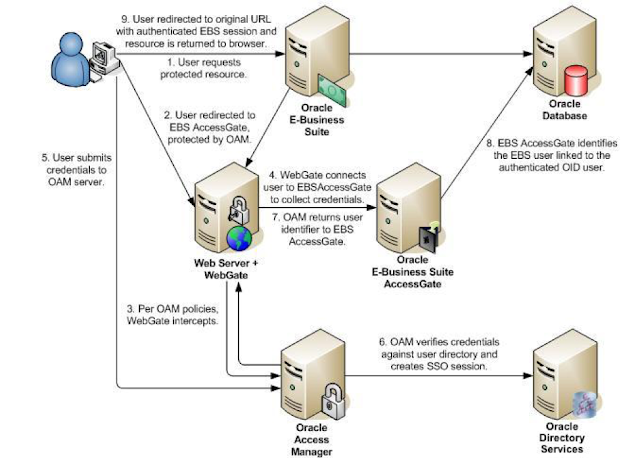Oracle Apps DBA - Simple Clonig Steps
How do you Clone your Oracle Apps System with Rapid Clone?
Let us say:
source is Prod and destination is Test
1. Make sure Test Server is ready
a. Remove existing apps systems and file systems in Test
b. That is look for all mount points sames as Prod
c. Look for the same file structures of the prod.
d. Make sure that same users should be there in test such as oracle and applmgr.
e. make sure that all the mount points and required file systems in test has required permissions.
2. Make Sure everything is ready in Prod.
a. Apply Rapid clone patch.
b. login oracle user, Goto $ORACLE_HOME/appsutil/clone/bin.
c. run perl ./adpreclone.pl dbTier.
d. login applmgr user, Goto $COMMON_TOP/clone/bin.
e. run perl ./adpreclone.pl appsTier.
3. Copy everything(Restore everthing) from Prod to test using some tool (Data protector) or manually, including database
4. After successfull restore from Prod backup/Prod source to Test, Go to Test system, rename all root directories and change ownership to respective users to test directories
Example : mv /y23/data/PRD /y23/data/TEST
mv /z24/data/PRD /z24/data/TEST
chown soracle:dba /y23/data/TEST
chown sapplmgr:dba /y23/data/TEST
5. Check correct oraInst.loc is there in your Test envirnoment
6. Statrt DBTier cloning program , go to soracle user, goto $ORACLE_HOME/appsutil/clone/bin. run the command
perl ./adcfgclone.pl dbTier
7. After running the script, it will ask inputs like
Target System Name, Target System Domain name, Target system Oracle Home, Number of Data Tops and its locations, Target System Display. Give all appropriate values
8. Then actual database cloning part starts. Mean while open other session of putty/telnet/x-manager. tail the logfile of cloning ex: tail -f $ORACLE_HOME/appsutil/clone/bin/CloneContext_032832939.log
9 . Open another session and user TOP command for CPU usage
10 .After completioin of script check log files for any errors
11. Important thing.. Update fnd_concurrent_requests.. Means cancel all existing requests. (change thes status of concurrent requests to completed)
12. Goto sapplmgr user, goto $COMMON_TOP/clone/bin execute the script as perl ./adcfgclone.pl appsTier
13. After executing script it will ask different inputs to enter such as apps password(prod password),Target System Database SID, Target Databse Server node, Target system domain name, Target systems APPL_TOP,COMMON_TOP, ORACLE_HOME, IAS_ORACLE_HOME, Target system Display, Locatino of JDK, UTL_FILE_DIR location. Give all appropriate values. Then scripst starts actual cloning process
14. Open another session of putty/telnet/X-Managers. Tail the logfile as tail -f $COMMON_TOP/clone/bin/CloneContext_06666724.log
15. Open another session of putty/telnet/X-Manager. See the CPU usage using top command
16. Hope appscloning completed successfully. Stop all apps services going $COMMON_TOP/admin/scripts/ContextName/adstpall apps/appspwd
17. Remove temporary files located in $COMMON_TOP/temp/*.t and *.tmp
18. If you have any customizations update init.ora as per your needs. You better to get initprod.ora from the PROD and change it as per your needs
19. Goto database drop production database links and create the database links needed in the test env
20. change the passwords of some users which can be used in test environment
21. Goto $APPL_TOP. update APPSORA.env with test database sid, test server name bothe in small letters and capital letters
22. Update profile options ICX Session Time out for site value
23. Change apps password in wdbsvr.app file located in $IAS_ORACLE/Apache/modplsql/cfg
24. Update schema passwords
25. delete all production logfiles came while refresh
Sharing real time knowledge,issues on Oracle Apps DBA and Oracle DBA
Subscribe to:
Post Comments (Atom)
Oracle EBS integration with Oracle IDCS for SSO
Oracle EBS integration with Oracle IDCS for SSO Oracle EBS SSO? Why is it so important? Oracle E-Business Suite is a widely used application...

-
Enabling TLS in Oracle Apps R12.2 Here we would be looking at the detailed steps for Enabling TLS in Oracle Apps R12.2 Introduction: ...
-
Oracle EBS integration with Oracle IDCS for SSO Oracle EBS SSO? Why is it so important? Oracle E-Business Suite is a widely used application...
-
Apps password change routine in Release 12.2 E-Business Suite changed a little bit. We have now extra options to change password, as well ...


3 comments:
Hi All,
Document is very good for practice. Just i want some information about this if we run adcfgclone what happens internally, at the same need to be run adpreclone every clone process?
And give me some information what is difference between in adcfgclone and autoconfig??
thanks,
Ramakrishna
Hi,
adpreclone and adcfgclone are utilities provided by Oracle to perform Rapid cloning on Oracle applicaions environment.
pre requisite to run adcfgclone is adpreclone.
adpreclone is required to run on dbTier and appsTier to perform complete cloning.
adpreclone creates a directory called clone on dbtier and appstier with all required files for adcfgclone to use it for cloning.
It collects techstack information,database information and genrates xml files,templates and driver files in clone directory. These files will be used by adcfgclone utility for cloning process, Infact adcfgclone utility also get created by adpreclone.
Hope you understand. Refer following URL and Oracle Doc Ids for more info
http://oracleapplicationguru.blogspot.com/2008/01/details-of-adpreclone-and-adcfgclone.html
Note: 799735.1 - Rapid Clone Documentation Resources, Release 11i and 12
FAQ: Cloning Oracle Applications Release 11i http://ID 216664.1
Descriptive Checklist for performing Rapid Clone with 11i/R12 http://ID 811715.1
Cloning Oracle Applications Release 11i with Rapid Clone http://ID 230672.1
Hi,
After having done with the clone successfully, I got to see some of the users coming up and complaining about the front end url not turnup.
Please let me know the importance of ICX session time out in the post clone procedure.
Also please do enumerate in details oracle apps authentication flow.
Post a Comment